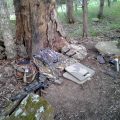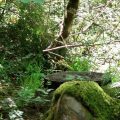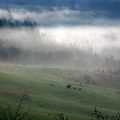Scout Your Way to Success on a Small Plot
A lot of guys say you should not scout before season. It gets the birds skittish. Ben Lee used to call such a thing “False Hearsay.” If you do it right, the birds never know you are there. If they do, do not think busting an occasional flock is going to doom your season.
I usually get on my flocks about a month before season starts. I am out at every opportunity. It is illegal to call to turkeys before season, and I do not recommend it. However, get in as close as I can and listen. The turkeys take me under their wing and teach me the secrets of the Universe. Mostly, they teach me their language and habits. Every year I learn something new.
After a decade of scouting like this I can tell you a lot of things. The flocks generally roost in about the same places, but there are always changes. I can tell how many are in the flocks. I can tell when the gobblers get really randy. This is almost always well before season starts. From there, I can figure out when the gobs will be coming out of their latent phase, and from there I can get a good idea what the first week or so is going to be like. While I am out walking around, I can start to see the clover grow, and count the acorns left from the fall. This tells me if my gobs are going to be in the woods or out in the fields. I also start listening for familiar gobbles. After a decade I can start to tell if The Garbage Pit Bandit will make a showing or whether Mister Natural will be strutting out by the old barn.
My scouting actually goes on all season and for the rest of the year as well. If I see lots of immature turkeys running about in the fall, I know there will be jakes aplenty the next spring. Some years I never see a hen with poults and I know something is up. Some times I listen for a gobble all through February and never hear one. Surprisingly those have turned out to be good years. For some reason the turkeys have all moved off the property for the winter. They come back in the spring and there is all sorts of mast waiting for them.
Set-ups
The other thing scouting does for me is let me pick my set-ups. My best set-ups are usually either all-natural or have a minimal amount of improvements. A hiker would normally pass them by without notice. I try to rely on two things: the natural folds of the terrain and the way light hits. I have to get down on my knees quite a bit and look at things from a turkey’s point of view. I hunt at the edge of things. Bright morning sunlight on the grass makes it hard for turkeys to peer into the shadows. A little dip or fold will keep the turkeys from seeing where I am until it is too late. These are the things, more than any high-tech equipment, that give a turkey hunter an edge. My favorite honey hole is in deep shadow all day. Coming from up-sun he cannot see in. Coming from down-sun there is a bend in the road that puts him in killing distance as soon as he steps around the curve.
This past season put me in mind of another important thing. If you read the Ranger Manual, Army Rangers are taught not just what to do when things go right, but for how to deal with things going wrong. Turkey hunters need to think the same way. If the gobbler hangs up at 200 yards, it is a good idea to know where you can go, without being busted, a hundred or yards closer. My Honey Hole has actually become a series of hides along several hundred yards of fenceline. 100-year oaks line a long-forgotten road with pasture on either side. Last spring, I finally called a bird off the roost after a decade. The way it happened was that I had picked one set-up for the Opener, overlooking a fenceline at the end of a pasture. There was a gobbler almost halfway back to camp that kept answering me. After a good long time trading calls, I decided to move to a spot 100 yards closer. Sure enough, that bird just hopped right down off his roost and came running over.
This post has already been read 328 times!
Views: 1










Comments
Scout Your Way to Success on a Small Plot — No Comments
HTML tags allowed in your comment: <a href="" title=""> <abbr title=""> <acronym title=""> <b> <blockquote cite=""> <cite> <code> <del datetime=""> <em> <i> <q cite=""> <s> <strike> <strong>